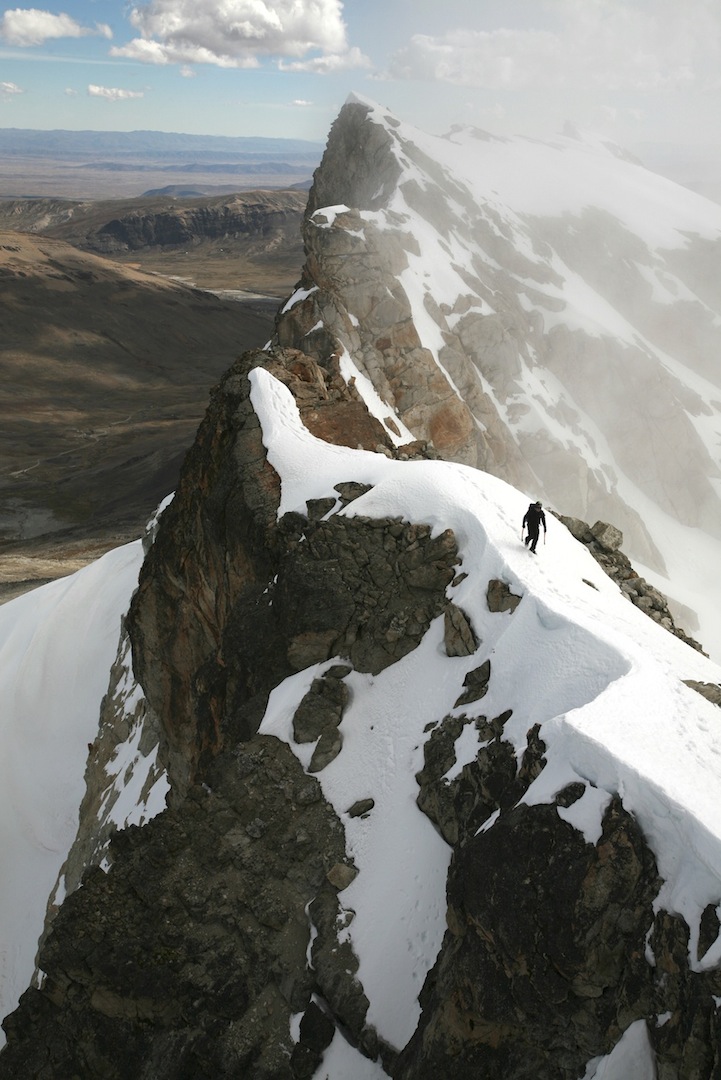Charquini (5,392m), south face; Pico Milluni (5,500m), east face; Pico Italia (ca 5,750m), east face
Bolivia, South America, Cordillera Real
 The imposing east face of Pico Italia is unmissable to anyone climbing Huayna Potosi; the steep, 500m granite face forms a fortress-like barrier along the western edge of the Huayna Potosi Glacier, and casts an alluring orange-obsidian glow in the early morning. Given its prominence in such a popular climbing area, it is surprising that the face had not previously been climbed.
The imposing east face of Pico Italia is unmissable to anyone climbing Huayna Potosi; the steep, 500m granite face forms a fortress-like barrier along the western edge of the Huayna Potosi Glacier, and casts an alluring orange-obsidian glow in the early morning. Given its prominence in such a popular climbing area, it is surprising that the face had not previously been climbed.
In May I returned to Bolivia to climb with New Zealand ex-pat Gregg Beisley, who lives in El Alto. With limited time available, and with the uncertainty of ongoing political demonstrations, strikes, and roadblocks in the chaotic city, we opted to minimize time traveling to remote regions by focusing on the Huayna Potosi region, located in the nearby southern Cordillera Real.
On May 15, to assist with my acclimatization, we climbed a new route on the south face of Charquini. [The mountain lies behind 5,300m Chacaltaya, the world’s highest ski piste, which in the age of global warming now seldom has enough snow to ski. The Charquini group has many different routes of ill-defined location, mostly by the late Stanley Shepherd]. We left Gregg’s house at 4 a.m. and drove to within one hour’s walk of the glacier below the south face. We climbed a five-pitch, sustained mixed line that led to the west-southwest ridge, which we followed to the summit. The crux first pitch was slightly overhanging and precarious (M5), and this eventually led to thin vertical ice (AI4), which eased off near the ridge.
To further extend my hypoxic exposure, and to determine whether I could sustain a high-intensity climb at altitude, on the 18th we climbed a new route on the northeast face of Pico Milluni (250m, two pitches, F5c/6a and 6b, then simul-climbing to the summit). We descended the obvious gully immediately north.
Next day we walked three hours from the Casa Blanca Hut to the base of Pico Italia and fixed two pitches (70m) in a sustained crack and chimney system, the first being the crux at around 6c (adequate natural gear, including two pitons). The following morning we left the hut at 4 a.m. and jumared the fixed lines in the warming rays of the sun. Carrying a full rock and ice rack, stove, and bivouac equipment made the jugging difficult, and in the end I had to haul while Gregg somehow managed to jumar up the chimney without flipping upside-down. We pulled up our fixed lines, tied into a single rope, and began long sections of simul-climbing between occasional harder steps.
The tightly packed granodiorite face doesn’t have clearly defined cracks or corner systems, making the way not obvious, but we followed?the most aesthetic path up the wall.?The climbing was engaging and well?protected as we linked disconnected?corner systems, chimneys, runout?slabs, and occasional overhangs. After?eight pitches, we pulled over the final?steep buttress and onto the summit ?ridge.
It was 2 p.m. and a steady stream of clouds blew from the verdant jungle to the east. Yet even as lightning forks pierced the blanket of Amazonian clouds, the weather in the mountains remained cold and stable. We changed into our ice climbing equipment, and Gregg led out on the last two pitches across the mixed ridge and onto the summit slopes. The final easy steps to the top felt like a formality after the demanding climb on the buttress. We had initially intended to follow the ridge all the way to the summit of Huayna Potosi, but after downclimbing mixed ground to the col between the two peaks, we opted to abseil to the glacier and cut across to the normal descent route on Huayna.
Overall, the length and variety of climbing made it a very demanding route, which took 16 hours to complete. Gregg and I have climbed a lot in Bolivia, and we feel this is the hardest climb in the Huayna Potosi region, and one of the hardest in Bolivia (600m, TD+).






